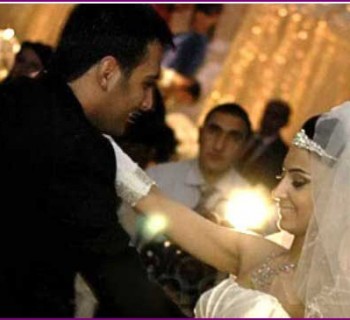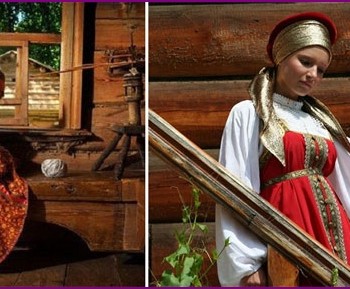Contents
- Wedding traditions of Armenia
- The rite of matchmaking
- «Conspiracy marriage»
- Fun walks
- After wedding ceremonies and customs
The Armenian wedding is interesting in that the ancient wedding traditions are still alive, although they have undergone some changes. All weddings at Armenians are held in strict observance of historically formed canons. This people is sensitive to such an event: the Armenian is ready to put everything to the last penny for the happiness of the young. Armenian wedding traditions are unforgettably bright and colorful, and the wedding is just an enchanting celebration with games, competitions, ransoms.
Wedding traditions of Armenia
Marriage in Armenian families has long been strictly according to seniority: until the elder brother got married, he had no right to start a younger family. There were a number of prohibitions on marriage:
- Marriage between blood relatives, up to the fourth, and sometimes even the seventh knee, was strictly prohibited.
- Nor was marriage permitted between two siblings and two sisters.
According to Armenian canons, adopted children and godparents were also considered blood relatives, and general bans were applied to them. Therefore, it was impossible to marry not only between the godfathers themselves, but also between their descendants.
Strictly condemned marriage of Armenians with Muslims.
According to historical Armenian tradition, the bride was chosen from her native or nearby village or city. Armenians married no more than three times, and the third time they married only a widow. There were cases of deviations from the generally established Armenian wedding traditions, but they were sharply condemned by society.
Armenia was previously characterized by early marriages. The girl was considered ready for marriage at the age of 12-16 years, the young man - at 14-20 years. Reaching 17 years old, the girl was already an old maid, and after 20 years she was called overripe. According to tradition, a wife was supposed to be several years younger than her husband. The age difference between the young could reach 15 years. They tried to marry an Armenian young man immediately after the service, and to marry the girl after graduation.
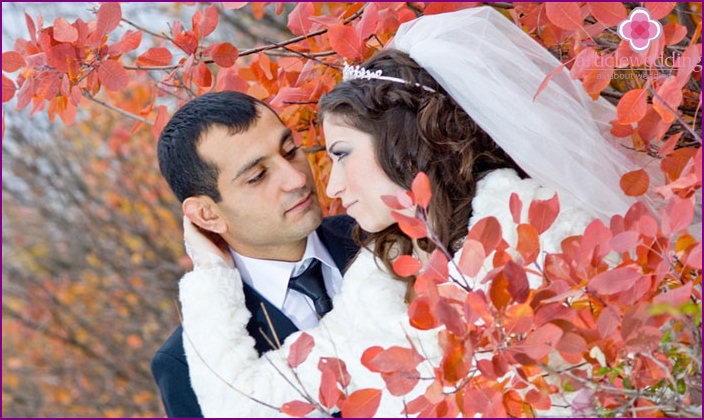
By tradition, the wedding itself was the main factor in creating a new Armenian family, and the official registration of marriage was carried out after the birth of the child, and therefore was considered a secondary matter. If the couple remained childless, then the relationship between them remained legally unformed.
When the Armenian guy and girl loved each other, and parents for some reason did not want to bless the marriage, the young simply ran away from home. Marriage among Armenians was considered indestructible, divorces were extremely rare, but the fact of marital infidelity could serve as a reason for divorce.
The main Armenian wedding traditions that formed many years ago can be called «conspiracy marriage» and «bride kidnapping». Previously, these traditions were strictly observed; today they are not so relevant, but they still exist..
The rite of matchmaking
Having chosen the girl he liked, the parents of the Armenian groom are preparing for the matchmaking. They choose one of their close relatives as a mediator in negotiations with future matchmakers. The mediator's task is to obtain the consent of the bride's father for the upcoming marriage. During the mediator’s stay in the bride’s house, the groom traditionally hung a comb or a large spoon on his pillar at home. Upon learning of the boyfriend’s intentions to marry, the girl’s mother consulted at first with her sibling.
The main matchmaking, according to tradition, occurred a few days later, the date was agreed in advance. Men went to the bride's parents ’home - close relatives on the male side, with them a mediator, and sometimes the groom’s mother. The parties exchanged usual greetings, talked about completely extraneous things - politics, weather, crops, and then in allegorical form with the help of various proverbs and jokes of the matchmaker informed why they had come. For instance: «We came to scoop a handful of water from your river into our river».
According to the Armenian tradition, the matchmaker’s proposal was never accepted immediately, even if the bride’s parents agreed. They found a reason to delay time, they said that they need to weigh everything, think it over. The matchmakers had to go this way more than once.
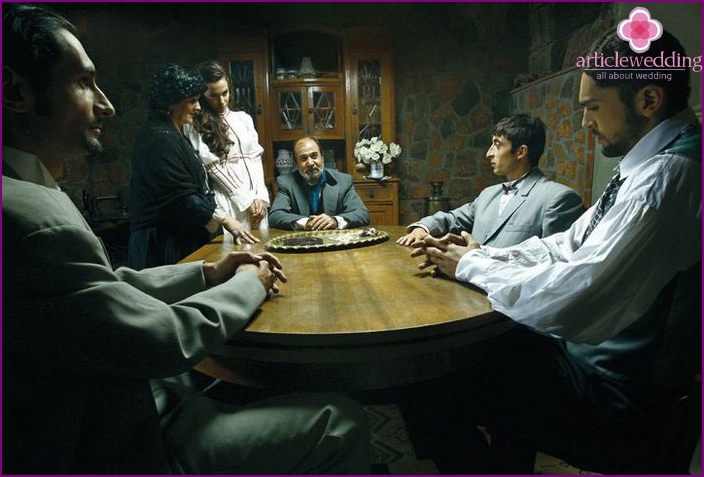
The bride’s father, in consultation with relatives, asking his daughter’s consent, also expressed his affirmative answer in an allegorical form: «Let's not argue, let our turtledove fly into your garden». This moment was called an official conspiracy by the Armenians; according to tradition, it was necessarily fastened with a gift - a ring or other decoration for the bride. After this, a table was set, the wine brought by the matchmakers was drunk..
«Conspiracy marriage»
Many years ago, among the peoples of the Caucasus, including among the Armenian people, it was widespread «conspiracy marriage», moreover, babies, young children and even unborn children (the so-called «betrothed») Parents who want to get married after many years, concluded an agreement, which was fixed by the fact that a piece of silver or gold was hung on the cradle with the girl, and sometimes a mark was made on the cradle.
This tradition was banned by the Armenian Church, which insisted that no one had the right to marry children until their will. If children, upon reaching adulthood, want to create families with other people, they should not be hindered. When the priest nevertheless held such a wedding, he was punished. But the people did not even allow the idea that such a marriage would not take place. Gradually tradition «betrothed» began to lose popularity, by the end of the twentieth century it completely disappeared.
A conspiracy marriage as an Armenian wedding tradition still exists today. His parents are chosen for the Armenian guy, a special role is given to the mother of the groom. Having fallen in love with the girl she liked, she consulted with her husband, sibling, other relatives. The family collected all the information about the girl, her family.
The positive qualities of the bride were:
- hard work,
- good health,
- modesty,
- the level of education,
- good specialty.
The girl’s appearance did not play a big role, the main thing is that she be a good wife and mistress. Her character and prospects were judged by her mother. What is mother - her daughter will be.
Fun walks
The Armenian wedding was traditionally celebrated in late autumn or winter, after harvesting. The main characters of the wedding party are the landed father and mother («Cavor» and «kavorkin»), single friends of the groom («azab») The main friend was called «azabbashi» - «the brother of the groom». On the bride’s side, the characters are her brother and sister. To conduct the wedding, they always invited the host, who proclaimed toasts, invited guests to sing, dance.
The father of the groom was considered the owner of the Armenian wedding. The wedding lasted from three days to a week, its duration depended on the material capabilities of the young parents. It started on Friday, and ended on Sunday. The Armenian wedding includes a number of interesting ceremonies. One of them is the pre-wedding bathing of the newlyweds, symbolizing purification:
- the young man bathed in the sty of his friends,
- girl - at home of her friend.
The ritual of bathing the bride was emotional, solemn, accompanied by songs, dances.
Another Armenian tradition is the baking of wedding bread. Bread was baked both at home by the groom and the bride. Friends to the sound of songs sifted flour, kneaded the dough in special wooden troughs, baked bread.
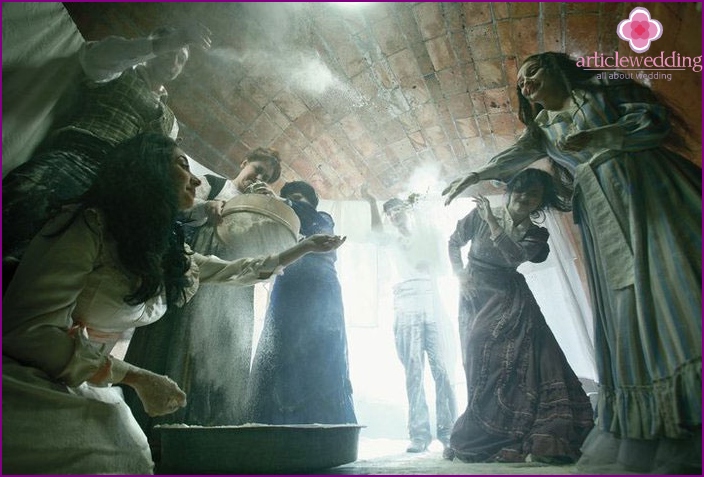
The Armenian wedding began unusually - at the same time in both houses. When the guests of the groom, having treated themselves enough, went home, the groom, accompanied by the wedding retinue and musicians, went to the bride and led with him a bull decorated with a garland of apples. According to the wedding tradition, this bull was stabbed to the sound of music and ritual dances, and his forehead was smeared with his blood.
The groom wetted the knife or dagger with the blood of a bull, folded it and put it in his pocket. The knife was opened only on the wedding bed. Since the bull, according to Armenian traditions, is considered a symbol of fertility, this wedding ceremony was supposed to contribute to a strong family, the birth of many children.
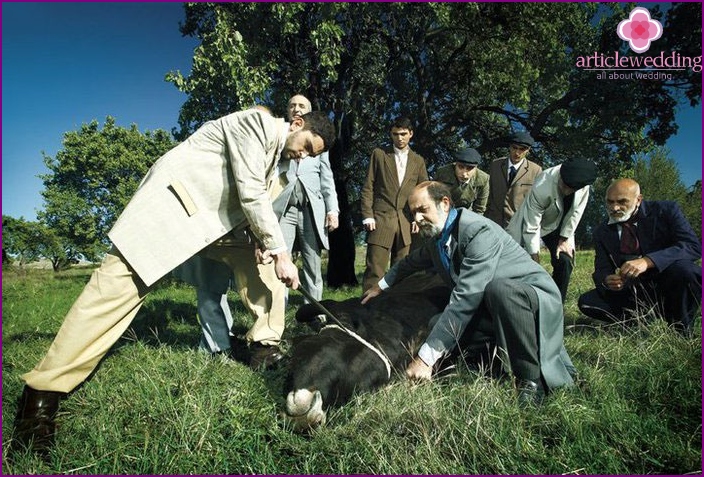
Leaving the groom’s house, the procession goes to his future wife, carries her wedding dress on a tray, and the bride herself, according to ancient tradition, sits at home in the corner of the room behind a special curtain. Relatives at the gate demand a ransom for her. After the groom got to his beloved, the wedding feast began, which lasted several hours. Then the guests went home, and the groom and the main friend remained to spend the night. Her girlfriend spent the night with the bride.
As in our time the Armenian bridegroom arrives for his bridegroom, see in the video below:
The next wedding day began with dressing the bride behind the curtain. Girlfriends put on a girl a wedding outfit to the sad melody of the Armenian zurna. It was not much different from everyday, except that it was sewn from expensive fabric. The young face was covered with a veil. Look at the photo how charming she is.!
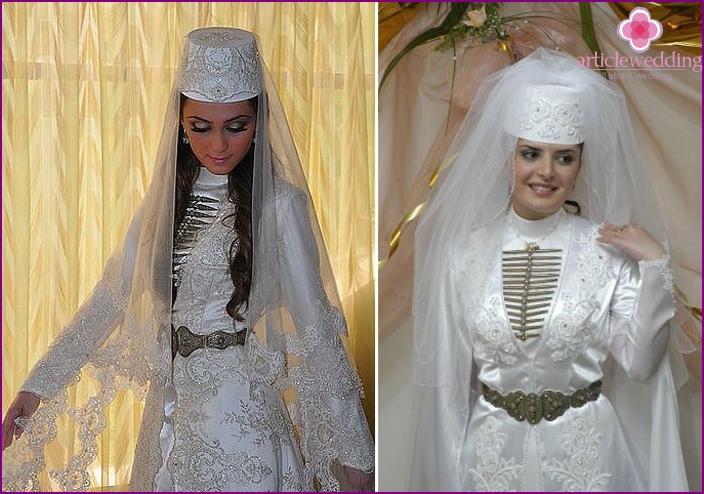
A married man with children took the bride out and set him next to the groom. He wished a couple of family happiness, health, many children.
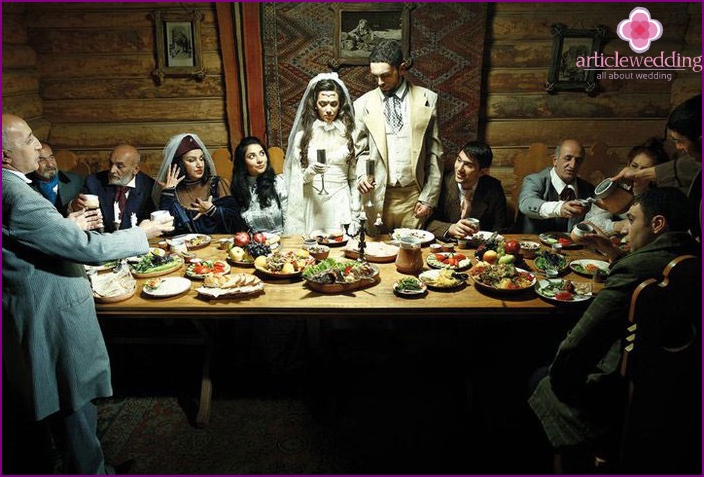
The newlyweds must have passed the wedding ceremony, without this they did not have the right to lie on the family bed.
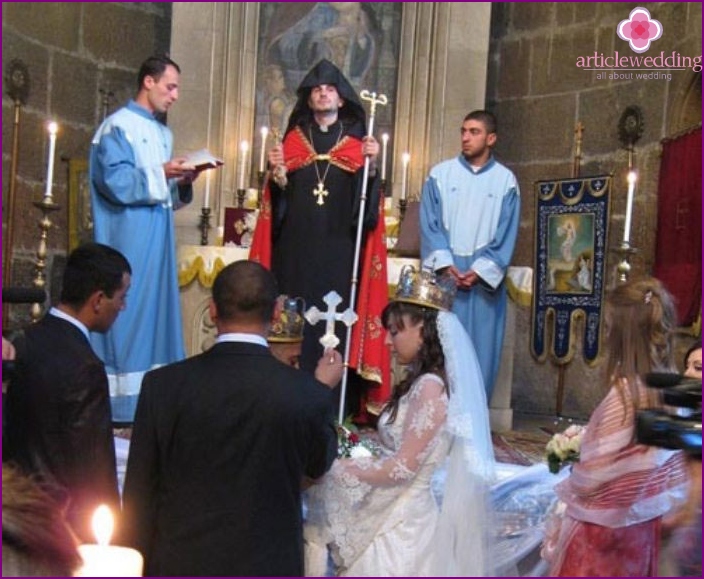
On the third wedding day, the future wife was transported home to the groom. In the morning he went with his relatives to get married. The bride's father handed the daughter from hand to hand to the future son-in-law, ordered to take care of her. The young wife said goodbye to her parents' house to sad songs, and then, together with the dowry, went home to her future husband. Relatives met them there: according to the Armenian tradition, they poured grain, sweets, nuts, small money on young people, which symbolized wealth and happiness.
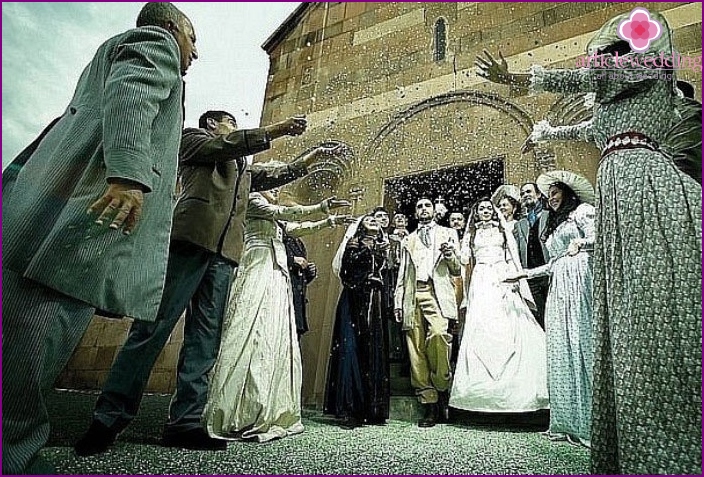
All Armenian wedding ceremonies were accompanied by generous refreshments, wedding songs, incendiary dances. The wedding table was distinguished by a plentiful treat, good wine, cognac, delicious sweets, various fruits, and also with witty toasts.
After wedding ceremonies and customs
The dowry of the bride in some areas of Armenia is carried after the wedding. Departure of the dowry is a post-wedding ceremony. The second rite is washing the bride’s head. Exactly a week after the wedding, the mother of his young wife comes to his son-in-law for the first time. She carries everyday clothes, a hairbrush, soap, a towel from her daughter and helps her wash her hair. In ancient times, this custom was strictly observed, the mother could not see her daughter until this day. Now it has a symbolic meaning.
If you are lucky to become a guest at an Armenian wedding, you will never forget the originality and true sophistication of this event, as well as the whole Armenian culture. Share your impressions in the comments, tell us what you liked the most, which of the wedding ceremonies you happened to be.
